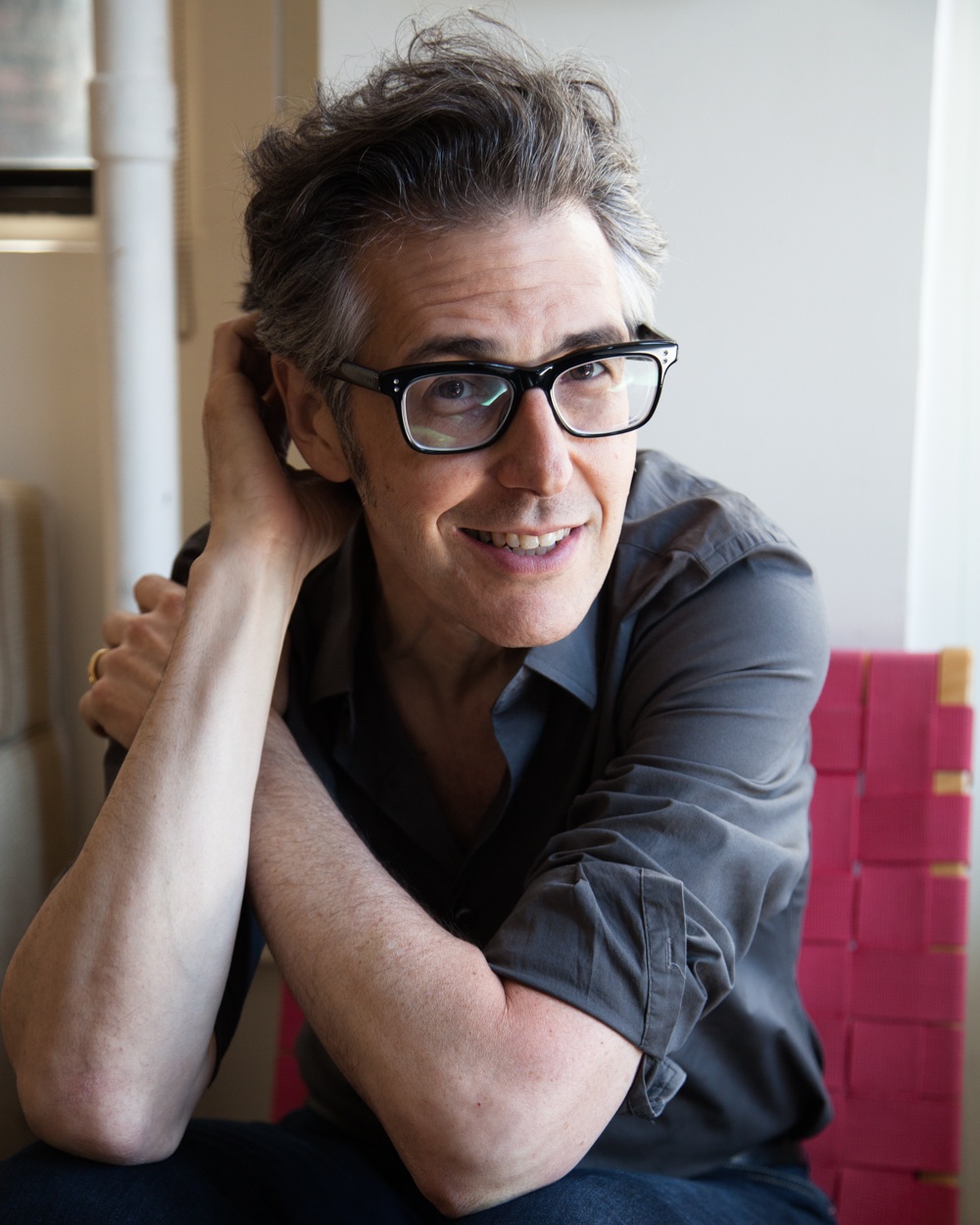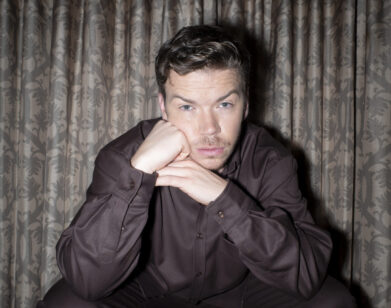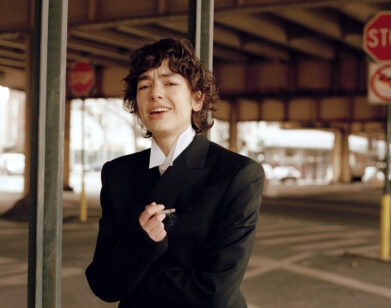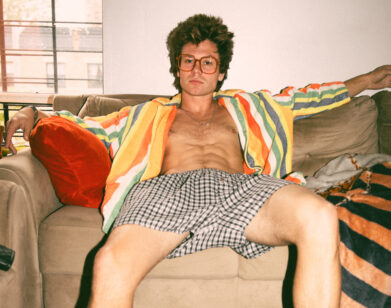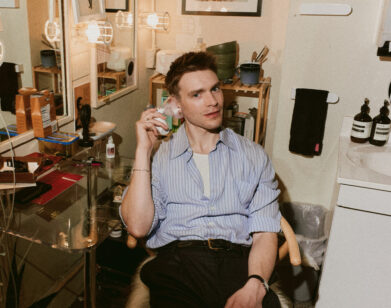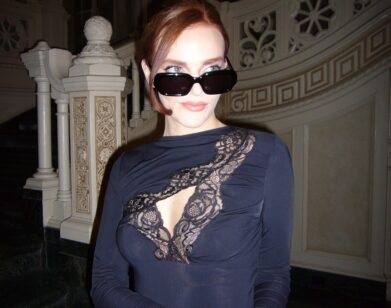Like Dancing About a Radio Show
When we went to interview Ira Glass at the New York studio of his phenomenally popular radio show, This American Life, he made a kind gesture midway through his first answer: he pulled the lever on his office chair to bring it down a bit, so we’d be at eye level.
It’s possible Glass would have done this no matter what. In nearly two decades as the host of This American Life, he’s earned a reputation as a sympathetic interviewer, so it only makes sense he’d be a sympathetic interviewee, too. But we’re tempted to offer another explanation: that Glass has become more aware of intrapersonal spatial relations lately, ever since he began co-starring in a dance show.
Cue the record scratch. Glass himself isn’t a dancer, and though he’s learned a lot about the craft over the last year and a half or so, he hasn’t become one. Rather, in Three Acts, Two Dancers, One Radio Host, he mostly leaves the dancing up to Monica Bill Barnes and Anna Bass, who have choreographed a show structured around several radio stories chosen—and narrated—by Glass. We spoke to him about this new developpé in his career.
ALEXANDRIA SYMONDS: How did you and Monica conceive of this show?
IRA GLASS: I saw Monica Bill Barnes’ dance troupe perform, and as I’ve said in other interviews—in fact, I say it in the show— there’s something about it that I had never seen in a dance show, where I felt like, “Oh, this is very much like what we’re trying to do.” Which is a counterintuitive thing, if it’s dance. We are working in opposite media—they use no words, it’s entirely visual, it’s entirely movement; and we use all words, there’s nothing visual, there’s no movement. And the fact that I could watch them and feel like, “Oh, you’re doing the same thing that I’m doing, but in a completely different language,” that had never happened for me at a dance show. And then I started just concocting things for us to do together. The first thing was, we did our show onstage at Skirball Center here in New York, and then set up cameras and beamed it out to movie theaters around the country, the way they do with the opera, and 28,000 or 30,000 people came out to see it. I got the idea for it from seeing these dancers, thinking, “How can I present these dancers to our audience?” Because I thought, what they’re doing is so similar; anybody who likes us is going to like them.
SYMONDS: Is it possible to say more specifically what about Monica’s style of dance that grabbed you?
GLASS: There were two things going on. One is that they think of themselves as entertainers—the thing is designed for fun. And at the same time, it’s about documenting something that’s real, that we feel: little human moments. It had both a documentary quality and an out-for-fun quality. In a way, that felt just like what we’re shooting for with the radio show. And they, as characters, don’t play the kinds of people that you see doing dance, usually, in the same way that on the radio show, I don’t play a more typical broadcast journalist news presenter—I try to be as much myself as I can. In the same way, they’re not these pretty little ballerinas spinning around, or these stony-faced modern dance robot people. They seem like really three-dimensional people when they perform, in a way that makes it easy to relate to and connect with. There was just something in the aesthetics of it that just felt very, very similar.
We did this event in May 2012 on stage, where they did two numbers, and then they choreographed a thing for this writer David Rakoff, who was in that show. It had exactly the effect that I thought; people were really into them. And I said to Monica, “Book some shows, and we’ll get the local public radio station to be the presenter, and I’ll do the on-air ads, and I’ll do a Q&A afterwards. Let’s choose four or five public radio cities—New York, L.A., Portland, Chicago—and I’ll go out with you guys for a couple days and more people will see you.” We did two shows here at Skirball that we sold out. It went great, I thought. And then Monica was like, “People are coming out, but I think they want to see more of you, since you’re in the ads. So let’s create something that would make you more a part of the show, and not just 10 minutes afterwards asking us questions.” That led to this show. This show started off as a series of little experiments: Could you combine dance and radio stories in a way that would make any sense? Basically, we started with the entire catalogue of everything Monica and Anna had ever danced, and the entire catalogue of everything I had ever put on the radio, and we just looked for what might match up in an interesting way. The thing we found pretty early on was that what didn’t work was for them to just illustrate what I was saying. For me to stand on stage and tell a story and them to act out the story—that just felt like you had a really bad day at the children’s museum.
SYMONDS: There’s no such thing as a really bad day at the children’s museum.
GLASS: Noted. [laughs] But you know what I mean? It felt really corny.
SYMONDS: So you’re more choreographed than that?
GLASS: It’s more like we learned—and maybe this is counterintuitive, or maybe this is exactly what someone would think, I don’t know—that it worked better if the dance was telling one story and I was telling another story, and then the two somehow connect in ways where you have to make the connections yourself as you watch. Which sounds—I have to say, now that I’m saying these words—really artsy, and this is so exactly the opposite of artsy. We just had to invent stuff that would talk to each other, in a way, but not duplicate.
Honestly, we didn’t even know where to begin. The first thing we tried was we were just like, “We have no idea how to start this, so why don’t we just start with a story about a dancer?”I dug up this story we had done 10 years ago, maybe, about this woman who was touring in a production of Riverdance. And it really is a story about the job of being a dancer in Riverdance, and one day, when the Riverdance performers all decided they were going to spice things up for themselves, what happened. It’s a very low-stakes story, but it totally takes you inside their world.
SYMONDS: When you were coming at this, I’m assuming that you don’t have a huge background in the fundamentals of dance?
GLASS: I know nothing about it.
SYMONDS: One of my favorite things about being a journalist, and I imagine this is true for you too, is the chance every time you do a story to deep-dive into what it’s like to have a life different from the one that you do. How much did you learn about the way dance functions?
GLASS: That’s been one of the most interesting things for me, and one of the great pleasures of this. I knew nothing about what it is to be a dancer, and now I feel like I know a bunch, through them. Even the most basic things, which I think dancers just take as a given, that I think no one would ever know. For example, on the day of a show, by the time we do the show for the audience, we’ve run the show once or twice. So by the time they’re performing this incredibly physical, difficult thing, we’re seeing the third time they’ve done it that day—these things that honestly, if I had to do after 15 minutes, as a not-trained person, I would have to take a nap. And for a non-dancer to see how quickly a professional dancer can pick up moves is shocking. There was a day that Anna had injured herself and we were doing a show in Denver; it was a 3000-person house, and it couldn’t be moved. They took another dancer they work with sometimes, and she learned the entire show by watching the video on the plane out there, learning it that morning, and practicing it in the afternoon. And then she performed the entire show—she learned a whole show in a day. That’s crazy.
SYMONDS: I think as a non-dancer, you don’t think about how dance really does just break down to a vocabulary.
GLASS: One of the things we did to prepare for the show was just that I interviewed the two of them about their jobs. I think two of the most interesting pieces in the show came out of those interviews—them talking about what it’s like for them on stage performing, that you hear as you watch them perform. I learned things from that. And one of the things we talk about in one of the pieces is something that I think is part of all performance, but especially something like what they do—what do you do with the sheer repetitiveness of your job? If you have a job in a dance show, you’re doing the same show eight times a week—what is the job of that like? Is that a good job or a bad job? In a way, it seems so deeply unglamorous and unsatisfying to march through the same thing over and over and over. How do you even feel interested in it as you do it?
SYMONDS: How did the triangular group dynamic play out for you, Monica, and Anna?
GLASS: They work together all the time and have for 11 years, and they’re super close, in a read-each-other’s-thoughts sort of way. And also, they both know what they’re doing. [laughs] And I’m an outsider. So I definitely feel like the third wheel in the group. In terms of the group dynamic, the one thing that happens is that Monica is used to being the boss, but I am also used to being the boss—but it is so utterly inappropriate for me to exercise that in this setting.
SYMONDS: [laughs] Yeah.
GLASS: Because I actually know nothing about what’s happening. And it’ll come out in little ways. Easily once a week, we’ll be running through something, and I’ll say, “Okay, let’s take that again from the top!” And Monica will be like, “You know, actually, I’m kind of the one who’s supposed to say that?” [both laugh] “Right, right, right, sorry. Of course.”
SYMONDS: I think what turns a lot of people off of going to see dance shows is that you often get the sense, watching dance, that what you’re seeing is theory performed at you. It seems like something it’s important to Monica to know the rules back-to-front and then flip them on their heads—which is something you do on the show, too.
GLASS: She has incredible chops, but then she puts them all at service of something that seems so effortless and direct and untheory-like. And the same way with the radio show: it’s informed by a tremendous amount of thinking about how to tell a story, and how narrative best works. There’s a lot of good reporting chops on the staff and among our contributors. But it’s all done in the service of, “I’m just sitting here telling you a story; it’s just you and me,” in the chattiest way possible.
SYMONDS: When you look at a piece of music, there are documented psychological or emotional reactions: this series of chords will cause—
GLASS: This feeling.
SYMONDS: This feeling. I think that’s true in dance, as well, when done well. Is that something that came into your unexpected dance education—the things we don’t understand that watching performance does to us?
GLASS: I never realized before this the emotional power of some really simple, corny tropes: people with top hats, people with batons, confetti going off, how important it is to smile. There’s a level of craft to that incredibly obvious, corny stuff. And I also never realized how the power of seeing people moving synchronously is a message in itself that is weirdly hopeful in some way. Watching Monica and Anna move around the stage doing everything together perfectly synchronously, including the most offhand gestures—it plays with your brain in this way, and does something that’s sort of hard to describe, but carries a message of taking ordinary gestures and making them seem uncanny. It’s almost like by doubling the way you step and the way you turn and the way you put your hand out, over two people’s bodies, it shows you what the gesture is, it puts a frame around it. It’s the simplest trick of dance! It’s the easiest thing that people can do, in a way. But I didn’t understand that, really.
SYMONDS: Do you think there are some stories that need language and others that are better expressed through movement?
GLASS: Honestly, I am so ignorant of how dance works that I can’t even imagine a story that you would want to tell through movement. Even after a year and a half of working every week with a dance troupe, I am not at an advanced enough level to have gotten to that point. Any story that I can consider worth telling is one that you could tell in words. [laughs] And I have no idea what is the story that you would want to tell through movement. It is literally beyond my power of imagination. [laughs] Because movement is such poetry, and in the end, I still am just a glorified interviewer/reporter, and that is not my territory at all. I’m on the stage with people who know that, but there’s never any illusion that I’ve crossed over to the other side. At all.
THREE ACTS, TWO DANCERS, ONE RADIO HOST PLAYS AT TOWN HALL IN NEW YORK SEPTEMBER 10, 11, AND 12, AND WILL CONTINUE TO TOUR THROUGH NEXT SPRING. FOR MORE INFORMATION ON THE SHOW, PLEASE VISIT ITS WEBSITE.

